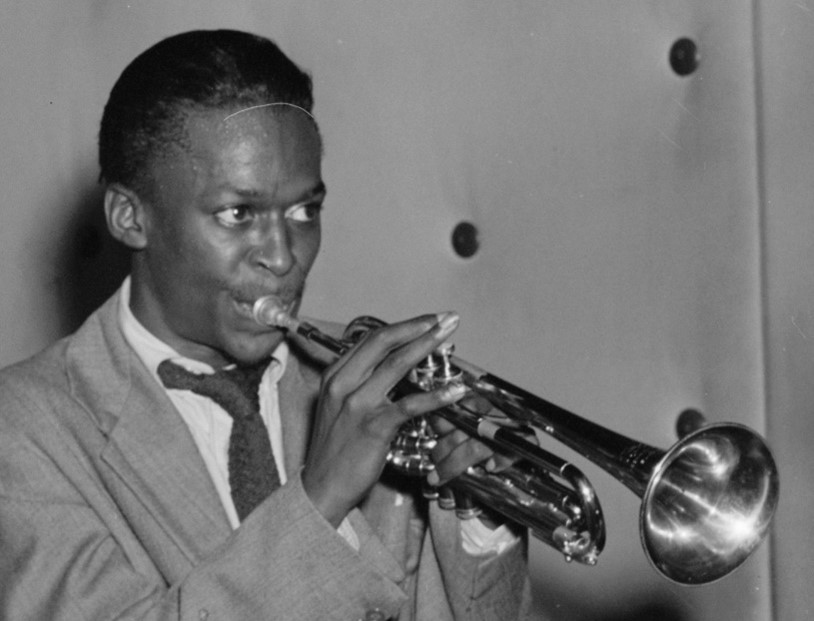
Cool Jazz 1
The 1950s witnessed two of the so-called "post-bop" styles: cool jazz and hardbop. Pioneered by Miles Davis (1926-1991), Gil Evans (1912-1988), and other younger members of New York's bebop community, cool jazz combined the innovations of bebop with a new sense of melodic and rhythmic understatement. By the late 1950s, cool jazz had become associated with Los Angeles. It included important figures like Lee Konitz, Chet Baker, Gerry Mulligan, Shorty Rogers, Dave Brubeck (from San Francisco), and others.
Cool jazz emerged when the up-tempo virtuosic extremes of the earlier style, bebop, had fallen out of public favor following a brief commercial breakthrough in the mid-1940s, and modern jazz found itself challenged by numerous emerging trends. Throughout the 1950s, as rhythm and blues, rock and roll, and other popular music idioms came to dominate sales charts, the jazz tradition splintered into several distinct subgenres. Of these, "cool jazz" proved to be among the most commercially successful. In the late 1940s, numerous musicians had begun to adopt more relaxed tempos, subdued instrumental timbres, and softer dynamics than were common in bebop while drawing on its harmonic innovations.
Listen to this 1959 live performance/recording of "So What" (1959) to hear these musical characteristics, which features Miles Davis on trumpet and John Coltrane on tenor saxophone.

Miles Davis and John Coltrane, "So What," 1959 [ 00:00-00:00 ]
This continuation of jazz after big band swing, was soon characterized in the press as "cool jazz" to reflect the new idiom's generally understated expressivity. Though the idiom had mixed-race origins involving various national jazz communities, cool jazz quickly became associated with whiteness and the West Coast, particularly California. Despite this joint media characterization, cool jazz involved many influential African American contributors who experts viewed as definitive voices of the genre. These latter musicians included the trumpeter Miles Davis and the Modern Jazz Quartet, neither of whom were directly associated with the West Coast jazz scene. Concerning the Modern Jazz Quartet (MJQ), the group was formally organized in 1952 by former members of Dizzy Gillespie's mid-1940s big band. The MJQ included the pianist and one-time Davis nonetA composition for nine solo instruments. member, John Lewis, the vibraphonist Milt Jackson, the bassist Percy Heath, and the drummer Kenny Clarke (who was replaced by Connie Kay in 1955).

Modern Jazz Quartet Django [ 00:00-00:00 ]
Like the Brubeck Quartet, the MJQ based their distinctive sound on cool jazz aesthetics and classical music. Listen to the Modern Jazz Quartet perform "Django" (1956) to see and hear why MJQ were called one of the most innovative jazz quartets of the cool jazz era.
The word "cool," which first appeared in African American jazz circles and Black slang in the 1940s, was used to describe a distinctly laid-back and hip aesthetic attitude, comportment, and personal style. However, it quickly crossed racial lines in pop culture through its adoption by a subculture of White enthusiasts and followers of jazz who were first known as hipsters (yet another African American slang borrowing) and in the later 1950s as beats or beatniks.
The mellow, laid-back, emotional restraint of the cool jazz idiom was manifest in its subdued expressive qualities, as well as in a new, classically derived tonal clarity that bore only a slight vibrato (especially among saxophonists). Other characteristics include a greater emphasis on composition and arrangement than bebop, an interest in counterpoint and chamber music-type textures, a preference for unusual instrumental groupings that included specific non-jazz instruments, and fondness for mellow-sounding, "pastel," ensemble sonorities. In general, cool jazz preserves the complex harmonic interests of bebop while simultaneously adopting restrained expressive qualities and a more relaxed rhythmic sensibility. These characteristics will be explained below with musical examples.
Boogie Woogie Bugle Boy
He was a famous trumpet man from out Chicago way
He had a boogie style that no one else could play
He was the top man at his craft
But then his number came up and he was gone with the draft
He's in the army now, a blowin' reveille
He's the boogie woogie bugle boy of Company B
Heebie Jeebies
Say, I've got the Heebies
I mean the Jeebies
Talking about
The dance, the Heebie Jeebies
Do, because they're boys
Because it pleases me to be joy







